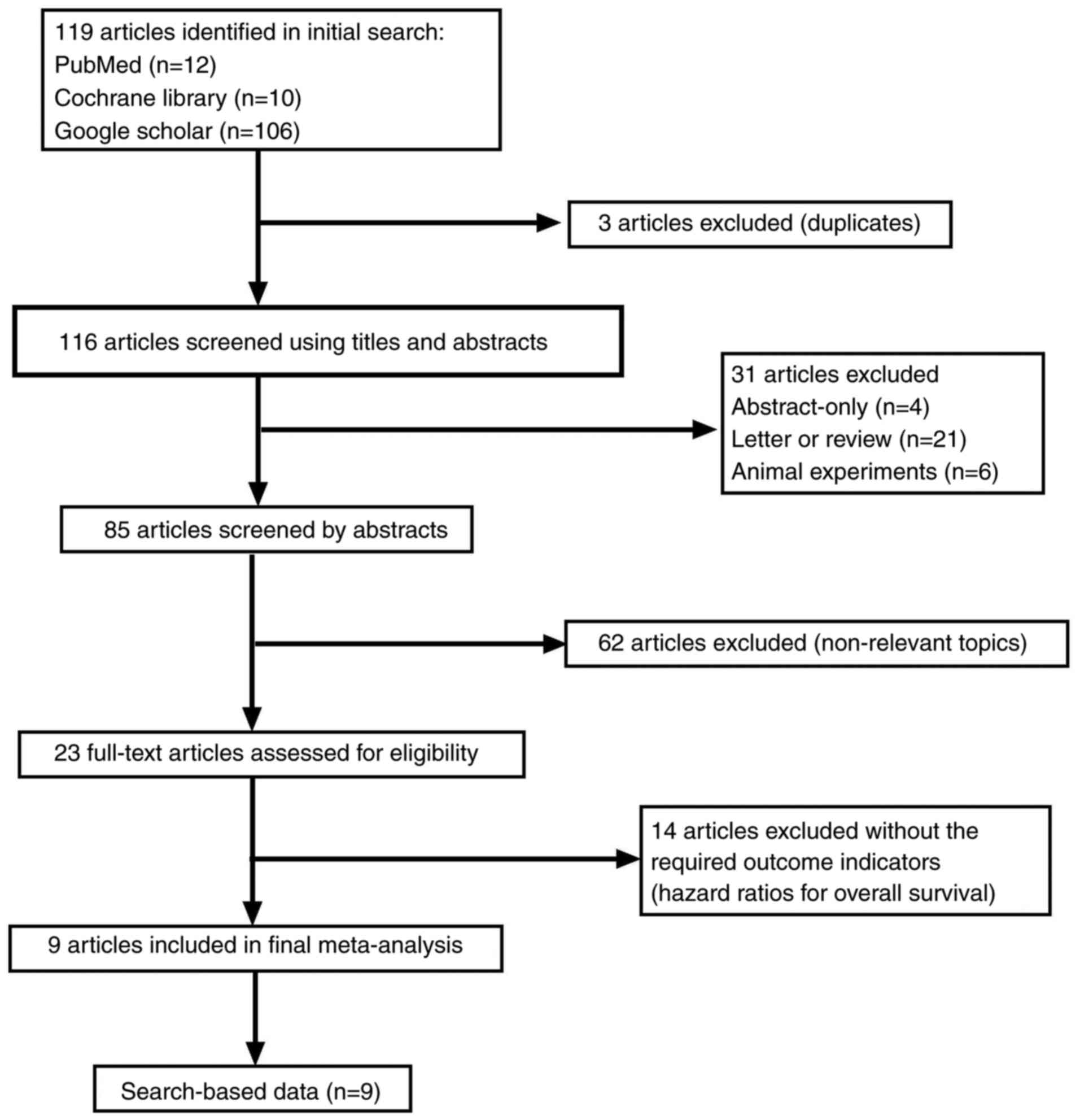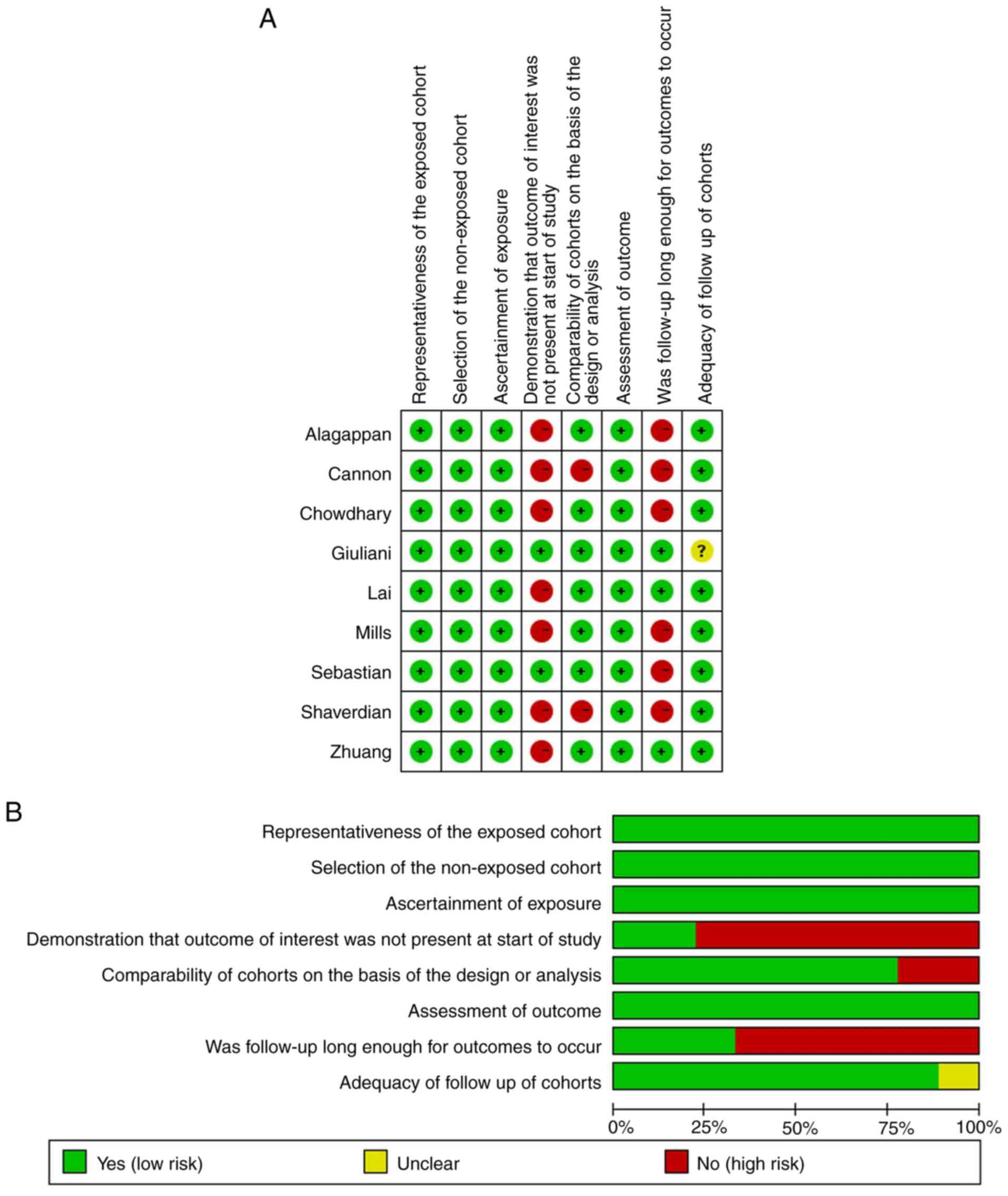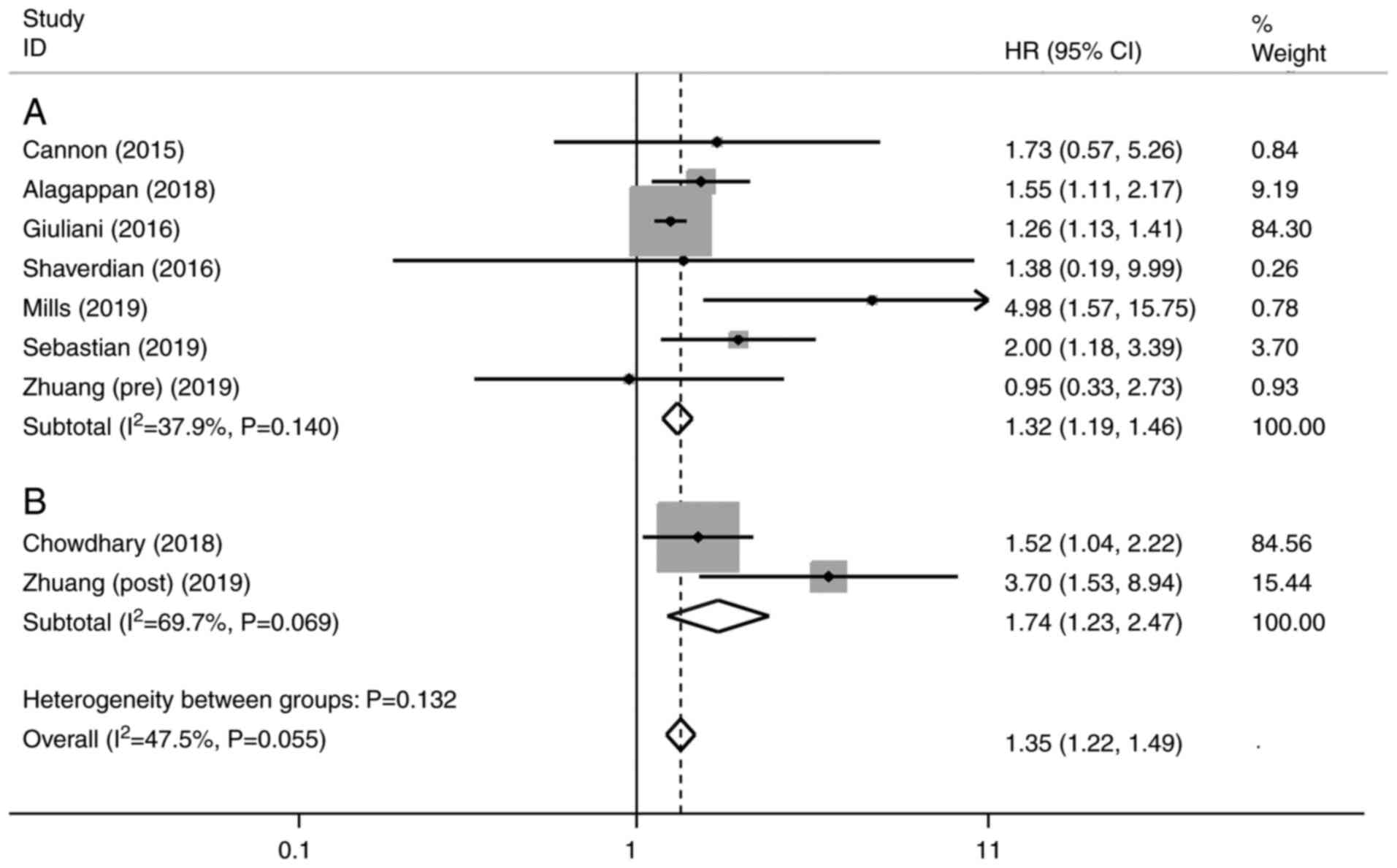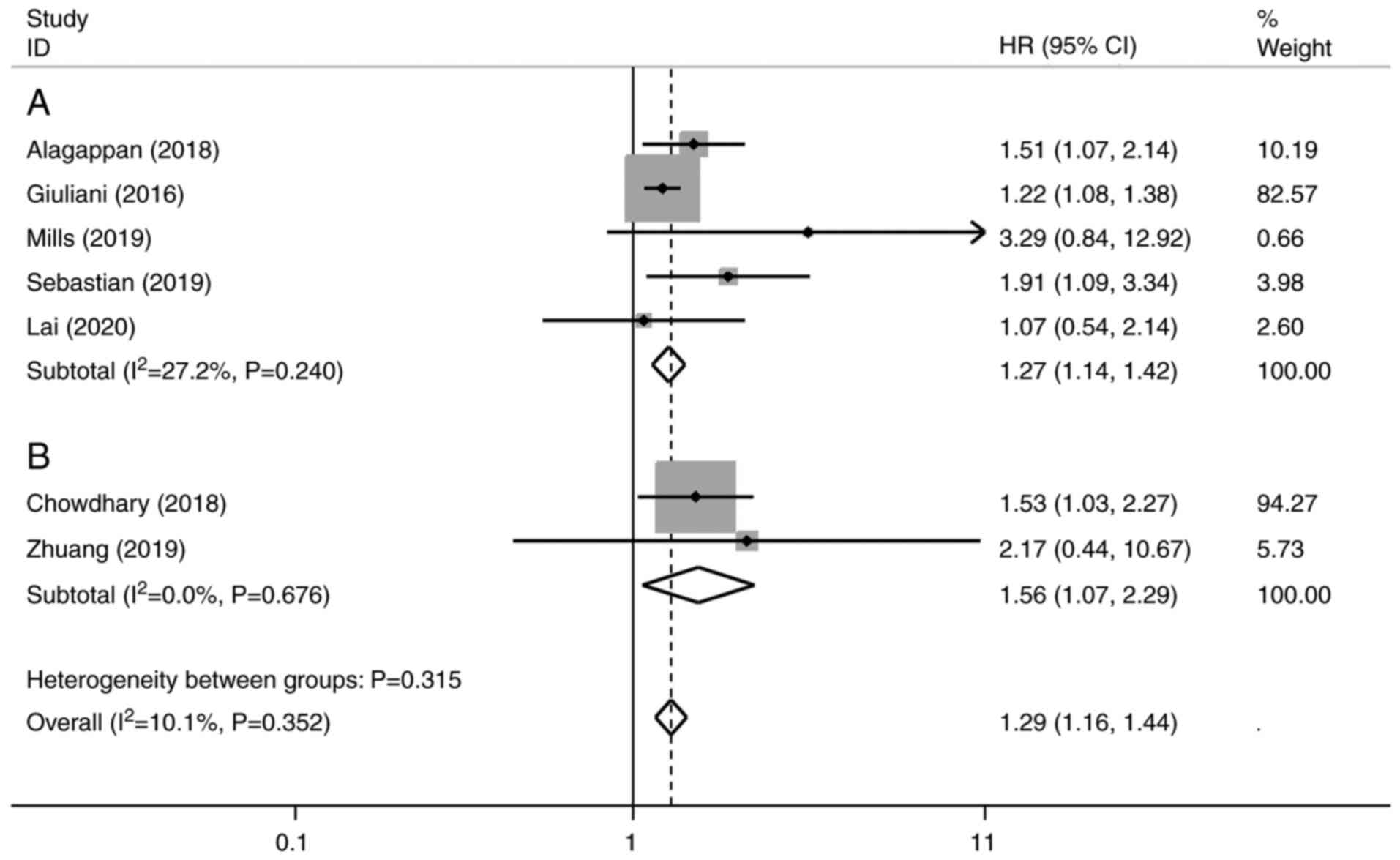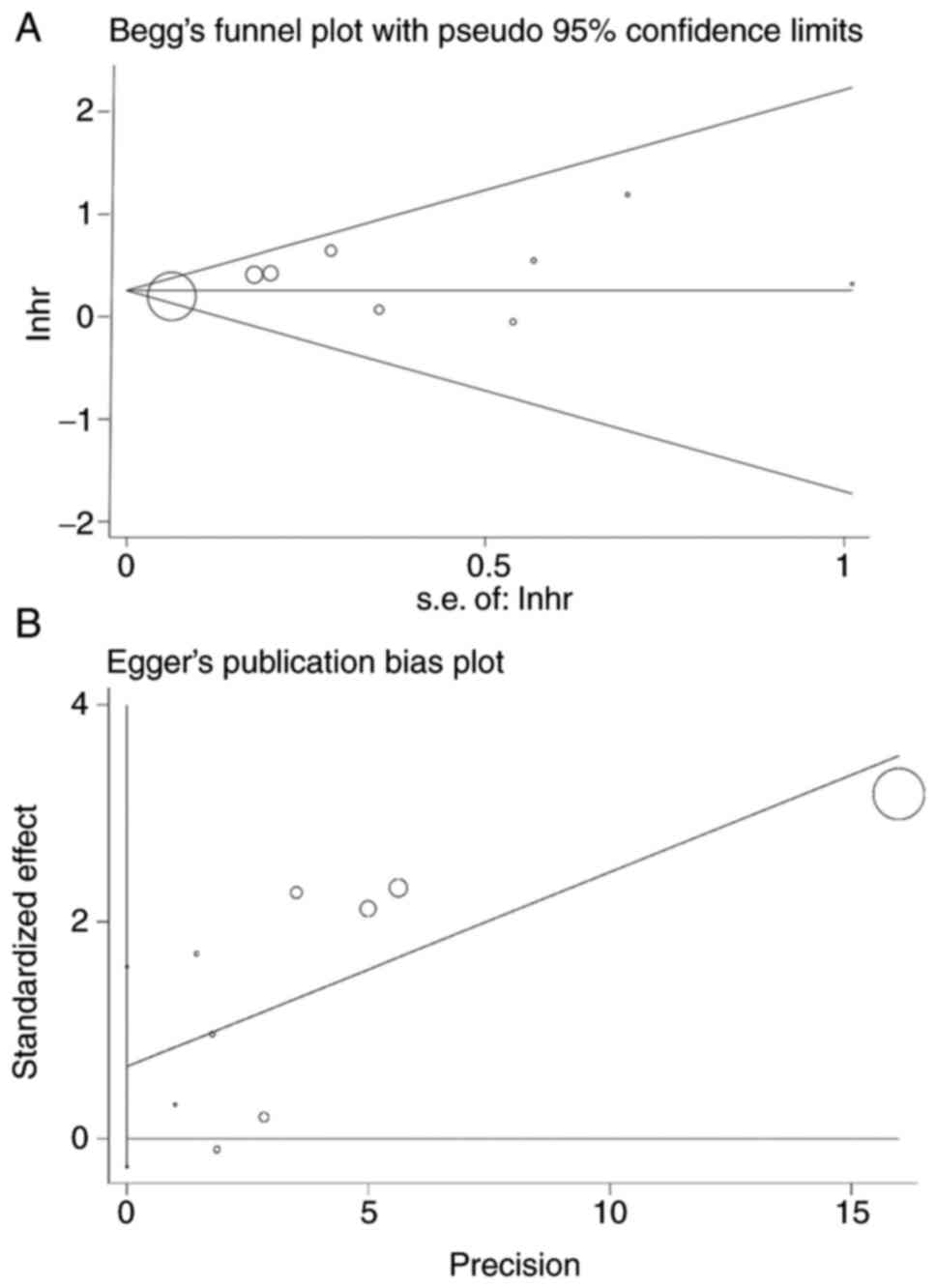|
1
|
Siegel RL, Miller KD, Fuchs HE and Jemal
A: Cancer statistics, 2021. CA Cancer J Clin. 71:7–33.
2021.PubMed/NCBI View Article : Google Scholar
|
|
2
|
Timmerman RD, Herman J and Cho LC:
Emergence of stereotactic body radiation therapy and its impact on
current and future clinical practice. J Clin Oncol. 32:2847–2854.
2014.PubMed/NCBI View Article : Google Scholar
|
|
3
|
Tandberg DJ, Tong BC, Ackerson BG and
Kelsey CR: Surgery versus stereotactic body radiation therapy for
stage I non-small cell lung cancer: A comprehensive review. Cancer.
124:667–678. 2018.PubMed/NCBI View Article : Google Scholar
|
|
4
|
Abdelfatah MM and Gochanour EM: Fiducial
placement for recurrent gastric cancer. Arab J Gastroenterol.
20:56–58. 2019.PubMed/NCBI View Article : Google Scholar
|
|
5
|
Schaub SK, Hartvigson PE, Lock MI, Hoyer
M, Brunner TB, Cardenes HR, Dawson LA, Kim EY, Mayr NA, Lo SS and
Apisarnthanarax S: Stereotactic body radiation therapy for
hepatocellular carcinoma: Current trends and controversies. Technol
Cancer Res Treat. 17(1533033818790217)2018.PubMed/NCBI View Article : Google Scholar
|
|
6
|
Palma DA, Olson R, Harrow S, Gaede S,
Louie AV, Haasbeek C, Mulroy L, Lock M, Rodrigues GB, Yaremko BP,
et al: Stereotactic ablative radiotherapy versus standard of care
palliative treatment in patients with oligometastatic cancers
(SABR-COMET): A randomised, phase 2, open-label trial. Lancet.
393:2051–2058. 2019.PubMed/NCBI View Article : Google Scholar
|
|
7
|
Mathew AS, Atenafu EG, Owen D, Maurino C,
Brade A, Brierley J, Dinniwell R, Kim J, Cho C, Ringash J, et al:
Long term outcomes of stereotactic body radiation therapy for
hepatocellular carcinoma without macrovascular invasion. Eur J
Cancer. 134:41–51. 2020.PubMed/NCBI View Article : Google Scholar
|
|
8
|
Schonewolf CA, Heskel M, Doucette A,
Singhal S, Frick MA, Xanthopoulos EP, Corradetti MN, Friedberg JS,
Pechet TT, Christodouleas JP, et al: Five-year long-term outcomes
of stereotactic body radiation therapy for operable versus
medically inoperable stage I non-small-cell lung cancer: Analysis
by operability, fractionation regimen, tumor size, and tumor
location. Clin Lung Cancer. 20:e63–e71. 2019.PubMed/NCBI View Article : Google Scholar
|
|
9
|
Costa-Pinheiro P, Montezuma D, Henrique R
and Jeronimo C: Diagnostic and prognostic epigenetic biomarkers in
cancer. Epigenomics. 7:1003–1015. 2015.PubMed/NCBI View Article : Google Scholar
|
|
10
|
Cai D, Xu Y, Ding R, Qiu K, Zhang R, Wang
H, Huang L, Xie X, Yan H, Deng Y, et al: Extensive serum biomarker
analysis in patients with non-small-cell lung carcinoma. Cytokine.
126(154868)2020.PubMed/NCBI View Article : Google Scholar
|
|
11
|
Grivennikov SI, Greten FR and Karin M:
Immunity, inflammation, and cancer. Cell. 140:883–899.
2010.PubMed/NCBI View Article : Google Scholar
|
|
12
|
Guthrie GJ, Charles KA, Roxburgh CS,
Horgan PG, McMillan DC and Clarke SJ: The systemic
inflammation-based neutrophil-lymphocyte ratio: Experience in
patients with cancer. Crit Rev Oncol Hematol. 88:218–230.
2013.PubMed/NCBI View Article : Google Scholar
|
|
13
|
Mei Z, Shi L, Wang B, Yang J, Xiao Z, Du
P, Wang Q and Yang W: Prognostic role of pretreatment blood
neutrophil-to-lymphocyte ratio in advanced cancer survivors: A
systematic review and meta-analysis of 66 cohort studies. Cancer
Treat Rev. 58:1–13. 2017.PubMed/NCBI View Article : Google Scholar
|
|
14
|
Raben M, Walach N, Galili U and
Schlesinger M: The effect of radiation therapy on lymphocyte
subpopulations in cancer patients. Cancer. 37:1417–1421.
1976.PubMed/NCBI View Article : Google Scholar
|
|
15
|
Ellsworth SG: Field size effects on the
risk and severity of treatment-induced lymphopenia in patients
undergoing radiation therapy for solid tumors. Adv Radiat Oncol.
3:512–519. 2018.PubMed/NCBI View Article : Google Scholar
|
|
16
|
Venkatesulu BP, Mallick S, Lin SH and
Krishnan S: A systematic review of the influence of
radiation-induced lymphopenia on survival outcomes in solid tumors.
Crit Rev Oncol Hematol. 123:42–51. 2018.PubMed/NCBI View Article : Google Scholar
|
|
17
|
Maehata Y, Onishi H, Kuriyama K, Aoki S,
Araya M, Saito R, Tominaga L, Oguri M and Araki T: Immune responses
following stereotactic body radiotherapy for stage I primary lung
cancer. Biomed Res Int. 2013(731346)2013.PubMed/NCBI View Article : Google Scholar
|
|
18
|
Moher D, Liberati A, Tetzlaff J and Altman
DG: PRISMA Group. Preferred reporting items for systematic reviews
and meta-analyses: The PRISMA statement. PLoS Med.
6(e1000097)2009.PubMed/NCBI View Article : Google Scholar
|
|
19
|
Hanahan D and Weinberg RA: Hallmarks of
cancer: The next generation. Cell. 144:646–674. 2011.PubMed/NCBI View Article : Google Scholar
|
|
20
|
Zhang Z, Deng C, Ma X and Liu X:
rs10865331 in 2p15 increases susceptibility to ankylosing
spondylitis: A HuGE review and meta-analysis. Clin Exp Rheumatol.
38:993–1000. 2020.PubMed/NCBI
|
|
21
|
Rezapour M, Rezapour HA, Chegeni M and
Khanjani N: Exposure to cadmium and head and neck cancers: A
meta-analysis of observational studies. Rev Environ Health.
36:577–584. 2021.PubMed/NCBI View Article : Google Scholar
|
|
22
|
Higgins JP, Thompson SG, Deeks JJ and
Altman DG: Measuring inconsistency in meta-analyses. BMJ.
327:557–560. 2003.PubMed/NCBI View Article : Google Scholar
|
|
23
|
Higgins JP and Thompson SG: Quantifying
heterogeneity in a meta-analysis. Stat Med. 21:1539–1558.
2002.PubMed/NCBI View
Article : Google Scholar
|
|
24
|
Egger M, Davey Smith G, Schneider M and
Minder C: Bias in meta-analysis detected by a simple, graphical
test. BMJ. 315:629–634. 1997.PubMed/NCBI View Article : Google Scholar
|
|
25
|
Begg CB and Mazumdar M: Operating
characteristics of a rank correlation test for publication bias.
Biometrics. 50:1088–1101. 1994.PubMed/NCBI
|
|
26
|
Zhuang Y, Yuan BY, Hu Y, Chen GW, Zhang L,
Zhao XM, Chen YX and Zeng ZC: Pre/post-treatment dynamic of
inflammatory markers has prognostic value in patients with small
hepatocellular carcinoma managed by stereotactic body radiation
therapy. Cancer Manag Res. 11:10929–10937. 2019.PubMed/NCBI View Article : Google Scholar
|
|
27
|
Shaverdian N, Veruttipong D, Wang J,
Schaue D, Kupelian P and Lee P: Pretreatment immune parameters
predict for overall survival and toxicity in early-stage
non-small-cell lung cancer patients treated with stereotactic body
radiation therapy. Clin Lung Cancer. 17:39–46. 2016.PubMed/NCBI View Article : Google Scholar
|
|
28
|
Sebastian N, Wu T, Bazan J, Driscoll E,
Willers H, Yegya-Raman N, Bond L, Dwivedi A, Mo X, Tan Y, et al:
Pre-treatment neutrophil-lymphocyte ratio is associated with
overall mortality in localized non-small cell lung cancer treated
with stereotactic body radiotherapy. Radiother Oncol. 134:151–157.
2019.PubMed/NCBI View Article : Google Scholar
|
|
29
|
Mills MN, Reddy AV, Richardson L,
Richardson KM and Kersh CR: The prognostic role of pretreatment
neutrophil to lymphocyte ratio (NLR) in malignant adrenal lesions
treated with stereotactic body radiation therapy (SBRT). Am J Clin
Oncol. 42:945–950. 2019.PubMed/NCBI View Article : Google Scholar
|
|
30
|
Lai L, Su T, Liang Z, Lu Y, Hou E, Lian Z,
Gao H and Zhu X: Development and assessment of novel predictive
nomograms based on APRI for hepatitis B Virus-associated small
solitary hepatocellular carcinoma with stereotactic body
radiotherapy. J Cancer. 11:6642–6652. 2020.PubMed/NCBI View Article : Google Scholar
|
|
31
|
Giuliani M, Sampson LR, Wong O, Gay J, Le
LW, Cho BC, Brade A, Sun A, Bezjak A and Hope AJ: Prognostic value
of pretreatment circulating neutrophils, monocytes, and lymphocytes
on outcomes in lung stereotactic body radiotherapy. Curr Oncol.
23:e362–e368. 2016.PubMed/NCBI View Article : Google Scholar
|
|
32
|
Chowdhary M, Switchenko JM, Press RH,
Jhaveri J, Buchwald ZS, Blumenfeld PA, Marwaha G, Diaz A, Wang D,
Abrams RA, et al: Post-treatment neutrophil-to-lymphocyte ratio
predicts for overall survival in brain metastases treated with
stereotactic radiosurgery. J Neurooncol. 139:689–697.
2018.PubMed/NCBI View Article : Google Scholar
|
|
33
|
Cannon NA, Meyer J, Iyengar P, Ahn C,
Westover KD, Choy H and Timmerman R: Neutrophil-lymphocyte and
platelet-lymphocyte ratios as prognostic factors after stereotactic
radiation therapy for early-stage non-small-cell lung cancer. J
Thorac Oncol. 10:280–285. 2015.PubMed/NCBI View Article : Google Scholar
|
|
34
|
Alagappan M, Pollom EL, von Eyben R, Kozak
MM, Aggarwal S, Poultsides GA, Koong AC and Chang DT: Albumin and
neutrophil-lymphocyte ratio (NLR) predict survival in patients with
pancreatic adenocarcinoma treated with SBRT. Am J Clin Oncol.
41:242–247. 2018.PubMed/NCBI View Article : Google Scholar
|
|
35
|
Singh R, Mishra MK and Aggarwal H:
Inflammation, immunity, and cancer. Mediators Inflamm.
2017(6027305)2017.PubMed/NCBI View Article : Google Scholar
|
|
36
|
Karki R, Man SM and Kanneganti TD:
Inflammasomes and cancer. Cancer Immunol Res. 5:94–99.
2017.PubMed/NCBI View Article : Google Scholar
|
|
37
|
Petrie HT, Klassen LW and Kay HD:
Inhibition of human cytotoxic T lymphocyte activity in vitro by
autologous peripheral blood granulocytes. J Immunol. 134:230–234.
1985.PubMed/NCBI
|
|
38
|
el-Hag A and Clark RA: Immunosuppression
by activated human neutrophils. Dependence on the myeloperoxidase
system. J Immunol. 139:2406–2413. 1987.PubMed/NCBI
|
|
39
|
Balkwill F and Mantovani A: Inflammation
and cancer: Back to virchow? Lancet. 357:539–545. 2001.PubMed/NCBI View Article : Google Scholar
|
|
40
|
Yuksel OH, Verit A, Sahin A, Urkmez A and
Uruc F: White blood cell counts and neutrophil to lymphocyte ratio
in the diagnosis of testicular cancer: A simple secondary serum
tumor marker. Int Braz J Urol. 42:53–59. 2016.PubMed/NCBI View Article : Google Scholar
|
|
41
|
Nakamura Y, Watanabe R, Katagiri M, Saida
Y, Katada N, Watanabe M, Okamoto Y, Asai K, Enomoto T, Kiribayashi
T and Kusachi S: Neutrophil/lymphocyte ratio has a prognostic value
for patients with terminal cancer. World J Surg Oncol.
14(148)2016.PubMed/NCBI View Article : Google Scholar
|
|
42
|
Takahashi Y, Horio H, Hato T, Harada M,
Matsutani N, Morita S and Kawamura M: Prognostic significance of
preoperative neutrophil-lymphocyte ratios in patients with stage I
non-small cell lung cancer after complete resection. Ann Surg Oncol
22 Suppl. 3:S1324–S1331. 2015.PubMed/NCBI View Article : Google Scholar
|
|
43
|
Denkert C, Loibl S, Noske A, Roller M,
Muller BM, Komor M, Budczies J, Darb-Esfahani S, Kronenwett R,
Hanusch C, et al: Tumor-associated lymphocytes as an independent
predictor of response to neoadjuvant chemotherapy in breast cancer.
J Clin Oncol. 28:105–113. 2010.PubMed/NCBI View Article : Google Scholar
|
|
44
|
Gooden MJ, de Bock GH, Leffers N, Daemen T
and Nijman HW: The prognostic influence of tumour-infiltrating
lymphocytes in cancer: A systematic review with meta-analysis. Br J
Cancer. 105:93–103. 2011.PubMed/NCBI View Article : Google Scholar
|
|
45
|
Stanton SE and Disis ML: Clinical
significance of tumor-infiltrating lymphocytes in breast cancer. J
Immunother Cancer. 4(59)2016.PubMed/NCBI View Article : Google Scholar
|
|
46
|
Boustani J, Grapin M, Laurent PA, Apetoh L
and Mirjolet C: The 6th R of radiobiology: Reactivation of
anti-tumor immune response. Cancers (Basel). 11(860)2019.PubMed/NCBI View Article : Google Scholar
|
|
47
|
Arnold KM, Flynn NJ, Raben A, Romak L, Yu
Y, Dicker AP, Mourtada F and Sims-Mourtada J: The impact of
radiation on the tumor microenvironment: Effect of dose and
fractionation schedules. Cancer Growth Metastasis.
11(1179064418761639)2018.PubMed/NCBI View Article : Google Scholar
|
|
48
|
Demaria S, Ng B, Devitt ML, Babb JS,
Kawashima N, Liebes L and Formenti SC: Ionizing radiation
inhibition of distant untreated tumors (abscopal effect) is immune
mediated. Int J Radiat Oncol Biol Phys. 58:862–870. 2004.PubMed/NCBI View Article : Google Scholar
|















